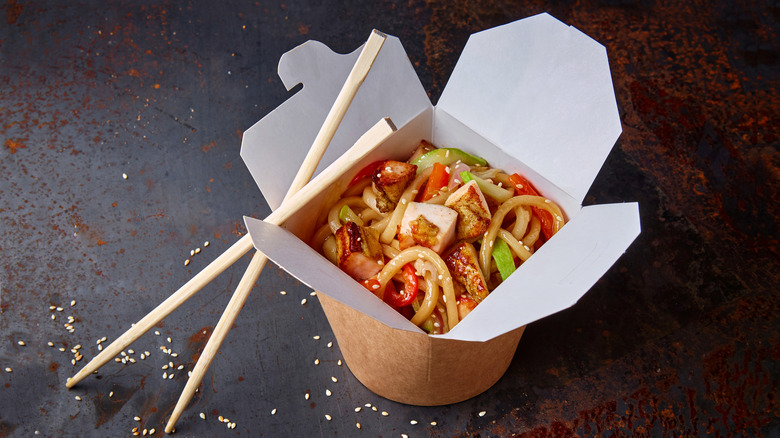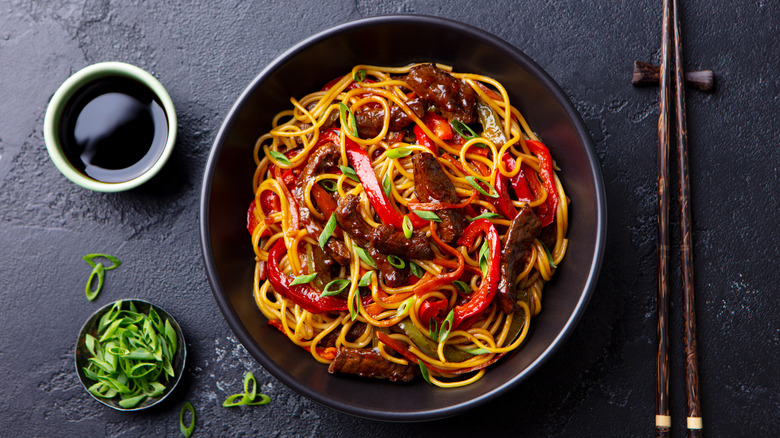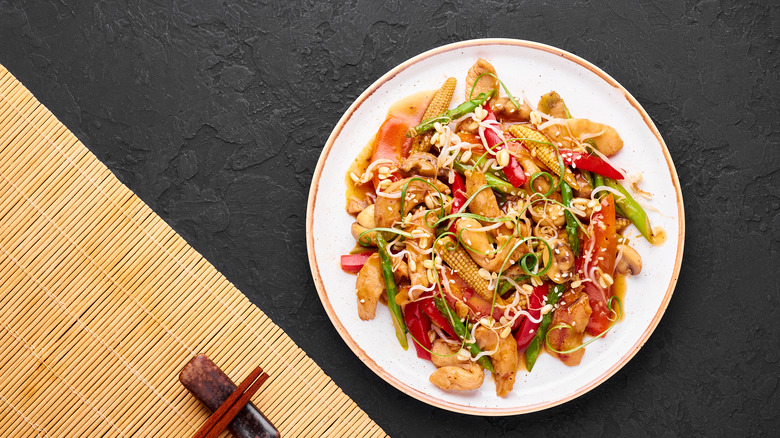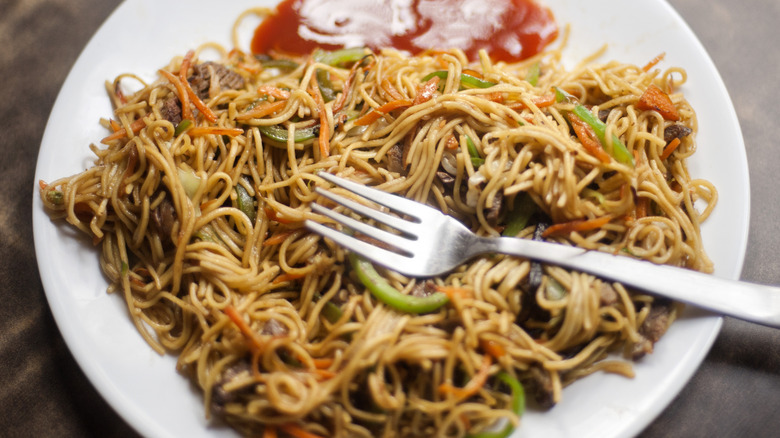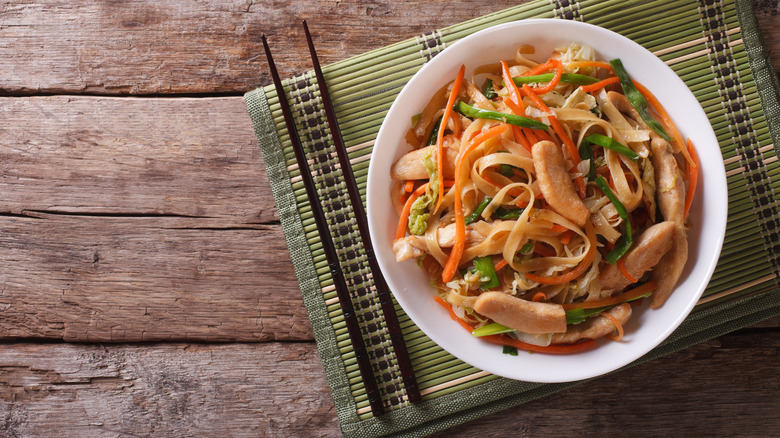Chop Suey Vs. Chow Mein: What Are The Differences?
Whether in a white paper takeout box or making at home from scratch, both chow mein and chop suey are staples in Chinese cuisine. There are plenty of similarities, as both dishes depend on the use of vegetables, protein, and a glorious, savory sauce to tie them all together. But there are some differences between these two entrees that make them unique, and some things to know that can elevate them into gourmet fare.
From where they originated to how they found their way into the hearts and stomachs of so many people in Western culture, we dug into the history of chow mein and chop suey. And, while the two dishes are often confused for each other, there are plenty of ways they stand out on their own. There's also some fun facts to know — one of these dishes doesn't even have a recipe! It might make you hungry just reading about it, so maybe have your favorite restaurant on standby for an order, just in case.
What is chow mein?
The Spruce Eats explains that, out of the two dishes, chow mein is the more authentically Chinese creation. This dish originated in Northern China (though historians aren't exactly sure of all the details or the timeline) and was brought to America by Chinese immigrants around 1850, according to Taste Atlas.
Though there are a number of regional tweaks, at its base it composes stir-fried noodles (crispy on the outside, soft on the inside), meat (whether it's chicken, pork, beef, tofu, or even seafood), and a range of super crunchy veggies that may include celery, cabbage, mushrooms, bean sprouts, and onions. A traditional oyster sauce is poured over the top to add extra flavor.
Like most international fare, the meal has been modified over the years for American preferences. As Taste Atlas notes, "Over time, it became more of a meat dish with deep-fried egg noodles smothered in thick gravy." So, while the origin of the dish itself is authentic, you may have to travel to China to get the real thing.
The standout feature of chow mein is of course the noodles that are parboiled and then fried, says Chowhound. The noodles really are designed to take center stage in this dish as it is the vessel for melding all the flavors. While not heavily fried to be extremely crunchy, chow mein noodles are also not as soft as lo mein noodles.
What is chop suey?
While the origin of chow mein seemingly has a direct line to China, the history behind chop suey is a bit more convoluted. Though, most can agree that chop suey was created in America utilizing Chinese influence.
One of the theories, says The Spruce Eats, is that the dish was founded by Chinese Americans during the Gold Rush while working in a mining camp as a quick solution to feed customers when the chef ran short on ingredients and used whatever he had in the kitchen. Another is built off the idea that it was requested by Chinese leader Li Hung Chang at a San Francisco Hotel in the 1890s — when he paid a visit, he wanted a meal with meat and vegetables and asked for it to be done "job suey," which translates to "in fine pieces." Yet another idea? Food & Wine says that Chinese immigrants may have invented chop suey as a way to use up their leftovers.
Just like its origin story, the dish has a loose recipe — but its base is always a protein, vegetables, and rice. The flexibility allows for any kind of protein and/or vegetables to be used, instead of just sticking to one flavor profile. This would help corroborate the story that the meal is based on a foundation of leftovers.
How is each dish made?
These two dishes may have similar ingredients (noodles vs. rice is their biggest difference), but they're prepared a bit differently. As noted by Chowhound, chow mein is made by first parboiling noodles until they have an al dente texture — some prefer to make a pancake-like base of noodles to top with the other ingredients. Then, the noodles are tossed in with crunchy vegetables and a protein. Once cooked, everything is finished with a savory sauce. Although there can be many variations on this sauce, most include the use of oyster sauce.
Chop suey's mixture of vegetables, protein, and rice is basically stir-fried. The vegetables and protein are chopped up into fine pieces first, and then tossed and stir-fried with a savory sauce, usually a soy sauce. As noted, this dish doesn't have an exact recipe and variations are always welcome so, like the chef that first created it, you can use anything you have on hand in your fridge to make it. Once the stir-fry is cooked and ready, it is then served over a bed of rice. While white rice is a traditional pick, you could also use brown rice for a more healthful option.
The top thing to remember when making both of these dishes is to keep the ratios in proportion. You'll want to get a bit of the rich flavor in every bite for the fullest flavor experience.
The nutritional differences between chow mein and chop suey
Because chop suey can be prepared in a myriad of ways, its nutritional content can vary, says Fit Community. But, because it's generally prepared with protein, vegetables, and rice, it's generally pretty healthy. One six-ounce serving is estimated to have 217 calories, 13.5 grams of protein, 8.5 grams of fat, and 1.2 grams of fiber. The 21.9 grams of carbohydrates can also be reduced by using brown rice or a smaller portion of rice.
When it comes to chow mein, while it might be assumed that fried noodles would make this dish unhealthy, the noodles themselves actually contain fiber, vitamins, and minerals, says Fit Community — just enjoy in moderation. For this dish, one serving has 203 calories, 4.6 grams of protein, 9.1 grams of fat, and 2.8 grams of fiber. However you can get more protein by adding in more of the meat source or tofu.
Both dishes are pretty congruent in calories and fat and can be altered to create healthier versions, if desired, by adding in a greater portion of protein and vegetables, and cutting down on the noodles or rice and the sauce. Fit Community also notes that choosing chop suey with rice may be the best option if you are health-conscious as fried foods tend to have other hidden things that may deter your health or fitness goals.
